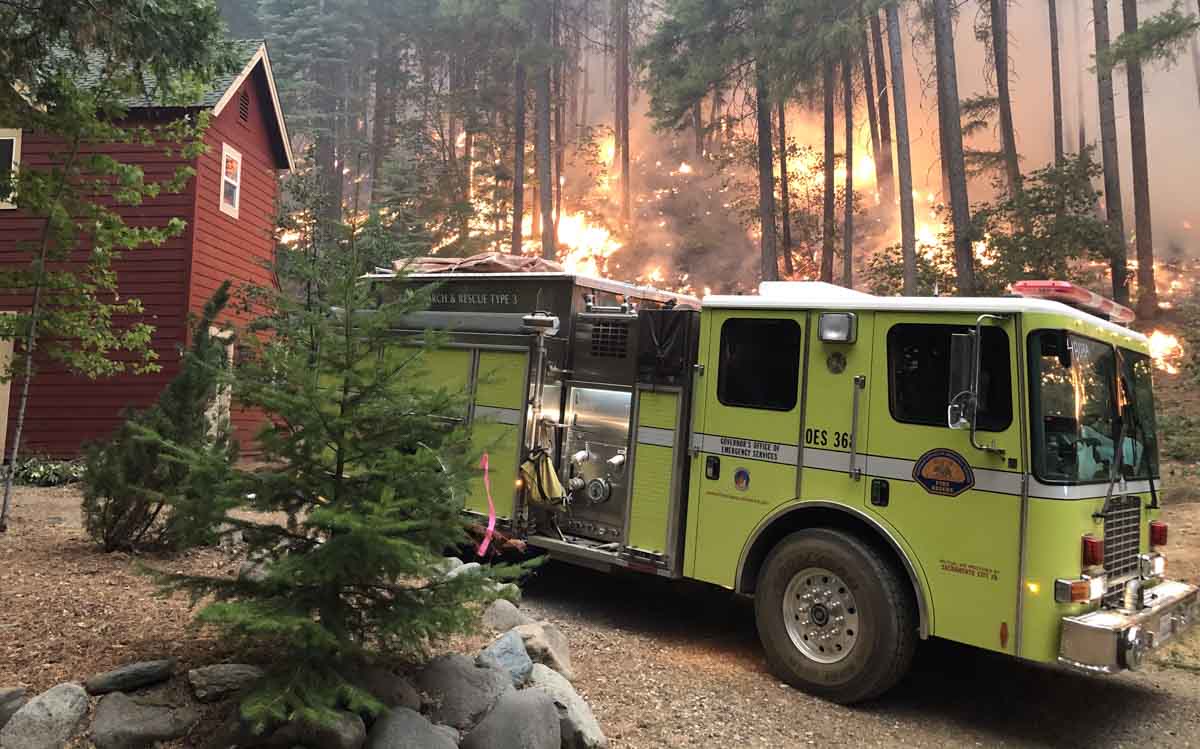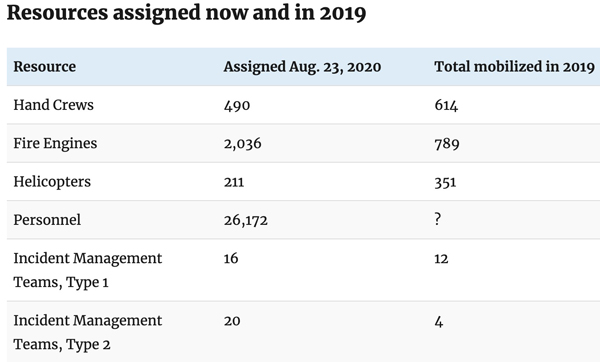August 23, 2020 | 6:48 p.m. MDT

It is not very often that there are more than 400 crews or 25,000 personnel assigned on fires at any one time, but those numbers have been exceeded with the rash of huge fires in California and Colorado.
The chart above compares the number of resources assigned to wildfires today to the total number mobilized in all of 2019, which was slower than usual. The acres burned in the lower 49 states in 2019 was 39 percent of the previous 10 year average. And the fires in 2019 were spread out over months — there was no extraordinary sudden need for massive mobilizations like is being required now in California and just before, Colorado. When there is an almost instant need for 15,000 or 20,000 firefighters, even the best-oiled mobilization system can struggle to keep up with the demand.
(To see all articles on Wildfire Today about the lightning fires in California, including the most recent, click HERE.)
There are only 16 of the highest qualified National Type 1 Incident Management teams that run the largest fires and all are currently assigned. If more were available they would probably be deployed as well. Some fires are possibly being staffed by Type 2 teams when a Type 1 team was requested. But most likely, they will do fine. (Correction: there are 16 National Type 1 teams, but some of the 16 Type 1 teams currently on fires today are organized at the state level.)
In the first three or four days after the lightning started August 16 in California we were aware of multiple situations on emerging fires that were severely understaffed by ground and air resources. On some incidents personnel were asked to work back to back shifts because there was no relief, and requests for engines, hand crews, air tankers, and helicopters were often unfilled. Those conditions have improved now that the system is fully geared up and aid is arriving from out of state, but there are still requests for resources that are unable to be filled (UTF).
One thing that is striking is that no Area Command Teams have been dispatched. This situation is what they are made for. None were assigned in 2016, 2018, or 2019. All three AC teams received limited administrative assignments earlier this year to help put together plans for the COVID-19 pandemic, but in three of the last four years they were not used on fires.
In 2019 the National Multiagency Coordinating Group (NMAC) which manages the AC teams was concerned that if they did not receive assignments some individuals on the teams could lose currency and qualifications in 2020. That issue may have been ameliorated with the COVID mobilization. But a person might wonder how similar pandemic planning is to managing multiple wildfires.
Here is how the NMAC described the function of Area Command Teams in a letter encouraging their use last year:
ACTs provide strategic leadership to large theaters of operation while significantly reducing the workload for agency administrators and fire management staff. Common roles of ACTs typically include facilitating Incident Management Team (IMT) transitions, in-briefings, and closeouts. Additionally, ACTs coordinate with agency administrators, fire staffs, geographic areas, and MAC groups on complexity analysis, implementation of objectives and strategies, setting priorities for the allocation of critical resources, and facilitating the effective use of resources within the area.


It is a concern to know that there are fire fighting resources not being utilized, but “draw down” numbers should be established by GACCs and resources should be released to join the fray down to the draw down level.
Unfortunately, there is that “hold on to what we have, just in case we need it, because we won’t be able to get resources if we need it.” My experience has been that resources, equipment, crews and teams can be re-assigned when situations require it by NMAC and GACCs. As an Area Commander that is something that you expect. Immediate examples come to mind, including the Wallow Fire in AZ & NM and from Missoula from multiple fires to add resources to new starts and re-deployed to Glacier NP when a Chalet was threatened (ultimately burned).
At PL 5 we should be sending everything down to the “draw down” level to where it can be utilized now.
Both SWA Type 1 Teams are unassigned.
And other resources not being used in California are many many pieces of water handling equipment that is being held here in R6 for their just in case ops. Where instead we should be in R5 helping out friends and neighbors. I do not know how our GACC gets away with this especially when we are not being paid to sit here, but we know how the government deals with these issues. I think everyone that is sitting should write up a invoice for the government and put down status severity, this is very upsetting for sure.
every. single. year.
Bill,
I always appreciate your situation comments, observations, smoke maps and the insight of your years of experience.
Thanks!
Bill,
Thanks for your comments about the current situation and the lack of use of the Area Command Teams. As an Area Commander for 9 years and currently serving as the Deputy Area Commander on Tim Sexton’s Team it is obvious that this situation could easily warrant two Area Command Teams in the field now and the other in rotation.
Beyond the apparent current need is getting the experience for the Area Command Team trainees who attended S620 last spring in Sacramento. It is a fire situation that would allow the ACTs to order multiple trainees and begin to get their Taskbooks completed.
Area Command Teams have proven their value time after time and were out continuously in big fire years and during hurricanes Katrina and Rita.
Perhaps its time for NMAC to mobilize the Area Command Teams and establish the complexes and subgeographic areas where they will provide strategic leadership for the fires in those areas. You recall I’m sure when the State of MT was divided into 93 E and 93 W on to Grangeville, ID. I was with the ACT for 93W & we had over 100 fires.
As you said, ” One thing that is striking is that no Area Command Teams have been dispatched. This situation is what they are made for. ”
With another “lightning bust” on its way, it is time to mobilize the Area Command Teams.
Jim Loach
Bill, corrrection to you stat’s, while their are 16 National Type-1 Teams. Not all are assigned. Two teams from R-6 and still available at this time. Just check nwcc web site it’s listed under overhead.
Today’s National Situation Report says 16 are assigned.
There are 16 federal Type 1 IMT, but several states have Type 1 IMTs also. 5 of the Type 1 IMTs assigned in California are CALFIRE Type 1 Teams.
Thank you, Mr. Bill Gabbert, for faithfully updating the public on what have been going on there in Northern CA regarding those nasty fires! I lived there for 30 years and so I am very concerned for the precious people there I count as my family as well as the friends I have accumulated through those 30 years!
The work you are doing is no less important than what those first responders/firefighters have been doing! May God keep you and your family safe from all harms and dangers! Surely Jesus is coming very soon – we are in the end times. Sadly, the world does not believe in the Bible or in God!